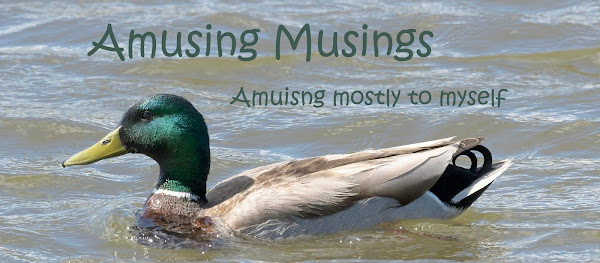Sunday, December 30, 2007
Good grief! Good Kharma!
Not much later, on my way down to the laundry room I saw a bag of groceries somebody had left in the elevator. It was just a few cans of tomatoes, some onions, and potatoes: Sunday stew-makings. So I rescued the staples and put a sign in the elevator so the owner can find me and claim them. So far, no knocks.
HAPPY NEW YEAR!
Tuesday, December 25, 2007
A sense of place

For Christmas I was given a lovely book, The Artists of Brown County, by Lyn Letsinger-Miller, with the introduction written by a childhood friend, Rachel Perry.
The book includes, in addition to nice reproductions of gorgeous, evocative oils and works in other media, numbers of photographs of the artists and of scenes from Brown County (Indiana), most from the first third of the 20th century, long before I came along to notice and take in my surroundings. What strikes me above all about these images is how little Brown County, and much of neighboring Monroe County, Indiana, where I grew up, had changed even by the 1960s. Now, of course, the story is quite different. But when I was a teenager, and had my first wheels, I spent untold hours exploring and relishing what I found along the back roads there.
Back when I was consumed by the fires of adolescence, my friends and I thought Bloomington and Nashville and beyond to Martinsville and even Indianapolis (pronounced, locally, Innynaplis) were the most distant of provinces, the most forgotten of backwaters, as out of the mainstream as one could get. This, of course, was not truly the situation, but reflected only our interpretation of the old, old rural way of life we saw that has in fact now become a source of sentimentality for us.
It also inspired me to think about the places that have deepest meaning to me. They are: Bloomington, where I was born, and nearby Brown County, Indiana; Martha’s Vineyard, where I learned to treasure Nature’s glory; Puerto Rico, where my mother’s roots were; Chicago, where I have lived for very close to 40 years; and above all, my newest and possibly deepest connection, the Greater Yellowstone area. Nice to ruminate about on Christmas afternoon.
The photo is of a T.C. Steele painting that I took at the The House of the Singing Winds, T.C. Steele State Historic Site, Nashville, Indiana, in 2005.
Sunday, December 16, 2007
Oh, that wild and whacky midwestern English!
I often hear, on Chicago's classical radio station WFMT and elsewhere, references to snottas. As in, Wolfgang Amadaeus Mozart's Trio Snotta.
This morning I was surprised to hear a TV spot advertising treatment for reptile dysfunction. God knows, we can't abide dysfunctional reptiles!
Saturday, December 15, 2007
Cultural revolution from South Africa
From Tsotsi, Presley Chweneyagae and Terry Pheto are actors to watch. Chweneyagae, though only 21 or 22 at the time the film was made, appears as the prematurely aged ganster-thug, Tsotsi. Pheto is stunningly lovely as the widow of bountiful breast, Miriam. And Hood deserves kudos perhaps most of all for knowing exactly when to stop.
Afterthought: Both Princess Magogo and Tsotsi are the fruits of black-white collaborations and cultural mixes. South Africa is a country to watch.
Monday, December 10, 2007
On the matter of naming babies

A colleague in Seoul, South Korea, and his wife recently had a baby girl. Here is the first message I received from him about her name:
"My wife and I have selected five names in Korean for our baby girl. After checking whether these names are matched well with appropriate Chinese characters, we will choose her name."
Today I received the following message about their decision:
"We have named her Na Yun. Na means an apple tree, and Yun means the sunlight. So, her full name means an apple tree under the sunlight."
Apple Tree under the Sunlight has to be one of the most beautiful, evocative names I've ever heard.
(Photo courtesy of her father, photographer unknown)
Thursday, December 6, 2007
Waterways Wednesday



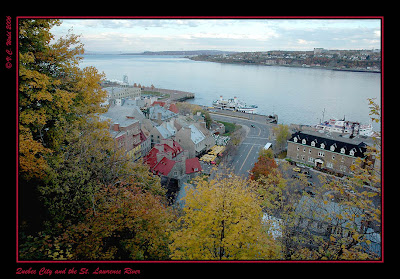

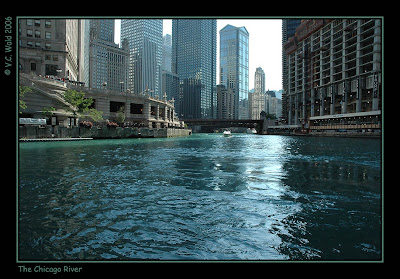
 Flickr was in a bad mood yesterday so I couldn't upload Waterways Wednesday until Thursday. These are some of my favorite waterways, starting with an anonymous river on the Leelanau Peninsula, Michigan; the mighty Snake River below the Jackson Lake Dam, Grand Teton National Park, Wyoming; the confluence of Hellroaring Creek and the Yellowstone River, Yellowstone National Park, Woming; the St. Lawrence River (Riviere Saint Laurent) from Quebec City, Quebec; the Mississippi River at the Quad Cities, looking from Iowa across to Illinois; the Chicago River, Chicago, Illinois; and La Mina River (Rio de la Mina), El Yunque, Puerto Rico.
Flickr was in a bad mood yesterday so I couldn't upload Waterways Wednesday until Thursday. These are some of my favorite waterways, starting with an anonymous river on the Leelanau Peninsula, Michigan; the mighty Snake River below the Jackson Lake Dam, Grand Teton National Park, Wyoming; the confluence of Hellroaring Creek and the Yellowstone River, Yellowstone National Park, Woming; the St. Lawrence River (Riviere Saint Laurent) from Quebec City, Quebec; the Mississippi River at the Quad Cities, looking from Iowa across to Illinois; the Chicago River, Chicago, Illinois; and La Mina River (Rio de la Mina), El Yunque, Puerto Rico.
Wednesday, December 5, 2007
Thursday, November 22, 2007
 Since we don't eat turkey on Thanksgiving day, I don't mind sharing this photo. I took it within a week of getting my digital camera, in April of 2004, Zion National Park, Utah. I was inordinately proud of it at the time; I'm happy to say, I've mastered the technique better of late. But the message works, does it not?
Since we don't eat turkey on Thanksgiving day, I don't mind sharing this photo. I took it within a week of getting my digital camera, in April of 2004, Zion National Park, Utah. I was inordinately proud of it at the time; I'm happy to say, I've mastered the technique better of late. But the message works, does it not?
Sunday, November 11, 2007
Another one of those days...

This is another one of those stretches of time when I have a lot I want to blog about and not enough time to compose my thoughts. This afternoon I'm going to Lyric Opera of Chicago's production of Handel's Julius Caesar, about which I will doubtless intend to post afterwards. I also have a lot of thoughts to share on the matter of widowhood: within the last six months, three friends of my generation lost their husbands, suddenly, to the kinds of things that take husbands suddenly at our age. And I still plan to eulogize the great Elizabeth Wacondo, who passed away this last July. In spite of all the losses, a co-worker and his wife were expecting the arrival of their first child this weekend. The continuity is well worth ruminating about.
And, as always, I want to comment on the changing seasons and wolfdom in Yellowstone, and on a DVD made by the Thermal Biology Institute at Montana State University...
Sunday, November 4, 2007
Finally, something really useful
In a way, I wish I hadn't found it. It might have been nicer to go through life without knowing what it meant.
Sunday, October 14, 2007
Amrchair Leaf-Peeping

Great shot of Electric Peak (within Yellowstone National Park) from the Web cam at Corwin Springs (a few miles north of the Park) this morning. It's absolutely wonderful to see abundant snow on its heights relatively early in the season. The thermometer on the Web page from which this was taken says it's 35o F this morning. Compare this photo to these I collected last summer during the height of fire season. Any wonder I'm thrilled?
The 4-legged beast in the distance is a cow or horse, not, alas, wildlife.
Wednesday, October 10, 2007
Leaf-Peeping in Door County

 Yeah, so OK I've not posted in a while. Part of my excuse is that we spent a long weekend in Door County, Wisconsin. The idea was to combine a little fresh air and exercise (it has several notably nice state parks for quality walking and scenery, though no wildlife other than some darned fine Midwestern birds) with a little retail therapy and some good eating. We achieved the latter two ambitions, but as to healthier outdoor activities, that was a bust. The reasons were the fact that the nation's midsection was bathed in humidity and unseasonal warmth on the very weekend we were seeking autumnal crispness. And we just felt like being fat, lazy and indulgent, especially given how much mileage we put in in Yellowstone and the Tetons last month. One exciting excursion was a most pleasant 45-minute ferry ride from Northport, at the peninsula's tippy-top, to the land-dot beyond known as Washington Island. Washington Island is the perfect place for doing nothing in beautiful countryside. Well, it's good for bicycling around, fishing, and probably for bird-watching on Rock Island, the next micro-land-dot in the archipelago reachable by an occasional passenger ferry. Washington Island is also the home of the modestly interesting and very productive Sievers School of Fiber Arts, which has the good sense not to spell itself fibre. If I had any talent what-so-ever in the sewing, weaving, knitting, or crocheting department, I might think it would be a lot of fun to take a course there - the setting is wonderful.
Yeah, so OK I've not posted in a while. Part of my excuse is that we spent a long weekend in Door County, Wisconsin. The idea was to combine a little fresh air and exercise (it has several notably nice state parks for quality walking and scenery, though no wildlife other than some darned fine Midwestern birds) with a little retail therapy and some good eating. We achieved the latter two ambitions, but as to healthier outdoor activities, that was a bust. The reasons were the fact that the nation's midsection was bathed in humidity and unseasonal warmth on the very weekend we were seeking autumnal crispness. And we just felt like being fat, lazy and indulgent, especially given how much mileage we put in in Yellowstone and the Tetons last month. One exciting excursion was a most pleasant 45-minute ferry ride from Northport, at the peninsula's tippy-top, to the land-dot beyond known as Washington Island. Washington Island is the perfect place for doing nothing in beautiful countryside. Well, it's good for bicycling around, fishing, and probably for bird-watching on Rock Island, the next micro-land-dot in the archipelago reachable by an occasional passenger ferry. Washington Island is also the home of the modestly interesting and very productive Sievers School of Fiber Arts, which has the good sense not to spell itself fibre. If I had any talent what-so-ever in the sewing, weaving, knitting, or crocheting department, I might think it would be a lot of fun to take a course there - the setting is wonderful.Otherwise it's not much of a happening place. But at Nelsen's we had a pretty good burger, yet more transfat-cooked French fries, and an interesting neighbor in the parking lot. The woody was in exquisite condition, and the Bernese mountain dog in the back seat as sweet and pretty as he (she?) could be.
I might add, the trees were at their absolute peak of fall color, and against the blue sky just made the heart sing.
Thursday, September 27, 2007
A photo, just to keep things moving along...
Tuesday, September 25, 2007
Icebergradio, for those who don't yet know about it
"IcebergRadio.com is owned and operated by Standard Interactive, a division of Standard Radio Inc., the largest privately owned broadcast company in Canada.
Iceberg Radio is Canada's biggest and best online radio portal, featuring over 100 channels across a variety of music genres, bringing you the widest and most dynamic music selection online, all the time.
Whether your passion is rock, pop, alternative, electronic, jazz or classical, Iceberg Radio plays your kind of music, live, 24/7.
Unlike other online music portals, Iceberg Radio isn't a repetitive jukebox: It's music that's programmed by people who live and breathe new sounds, who don't just work off the charts, and who tailor their programming to what the audience wants to hear."
For those who listen to music through their computers, I can recommend this site above all others I have ever used. The variety and quality of the music, organized into "genres" with an additional selection of sub-genres, is unparalleled on the Web. My tastes vary widely and everything I've delved into from their menus has been more than satisfying. There are no replays, the stream is reliable, "Now Playing" is accurate and full of useful information (though on my system it has to be manually refreshed). And although there is occasional voice-over identification, and of course paid advertising on the site, it is in no way obtrusive. Try it for a treat!
Tuesday, September 18, 2007
Moose-O-Rama
Thursday, September 13, 2007
Monday on the bus
When I was a child, in a small Midwestern university town, with one exception from grade school, I knew no one of any extraction other than Christian- Caucasian-European. By the time I was in junior high school, I had several friends who were Jewish, which though distinctly non-mainstream, was not discriminated against, and a couple of others who spoke with accents, but from European, not New World Hispanic or Asian countries. In high school I knew three or four black kids. In the late 1960s-early 1970s, college, in the same neighborhood I live in now, was only modestly more diverse. How the globe has shrunk since then. It's only chance that I even happened to notice the world representation on the bus. Most of us no longer even think about those things.
Sunday, September 9, 2007
The safe return

We've been back in Chicago for five full days, and we're relishing the many highlights from our quick Yellowstone-Tetons trip. With KLK along there was ample hiking, as evidenced yesterday when I took off my beat up old nail polish to reveal a great toe under the nail on my left foot that was a very pretty shade of light blue-green - that's what happens when you jam it on rocks and roots over and over again. It was worth it. Saw good friends, watched wolves and bears, lost our breath over scenery, dodged wildfire smoke - successfully on many days, obvious in this shot of the bright three-quarter moon. Now to go spray a little (well, OK, a lot) of Febreeze on my pack in the hope that it won't be tooooo obnoxious when I pull it out of its home in an old pillowcase next time.
Sunday, August 26, 2007
God, and the Friendly Skies, willing...

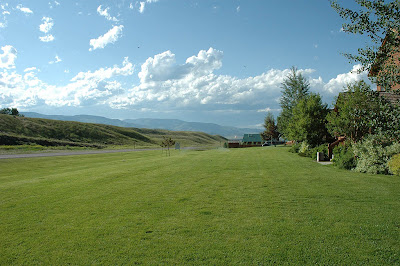
Tomorrow we leave for a short, intense trip to Yellowstone and the Tetons. Our first night will be in Chico Hot Springs Resort and Spa, in the highly irrigated Paradise Valley due north of Yellowstone's North Entrance. It's most certainly one of the prettiest spots on the face of the earth (and Chico's is consistently one of the best restaurants I've ever eaten in, by the way). Compare the photo of the irrigated greensward along the approach to the resort with the photo taken exactly two years ago of the Lamar Valley in Yellowstone. The lump to the left of the road is Soda Butte Cone, an active thermal feature out there all by itself, relatively far away from any other thermal activity.
Note, of course, the color of the brush, mostly sage and forbs, (only a little actually qualifies as grass.) This is what Nature looks like at the end of a long, hot, dry summer. The fires creating the choking ash and smoke of the Web cam captures, below, have been quenched, and primarily through soaking rains rather than fire-fighting efforts, though some are still smoldering in places, and some small new ones have started. In spite of what some pundits claim, that the fires are due to chronic "mismanagement" of the forests, in truth their occurrence cannot be 100% managed. They are, and always have been, part and parcel of Mother Nature. We only hope they contain themselves to uninhabited areas and don't endanger lives or property.
Trip report to follow in a couple of weeks!!
Friday, August 17, 2007
Don't breathe too deeply
Sunday, August 5, 2007
Saturday, July 21, 2007
Pan's Labyrinth
I wonder how many Americans (at least among non-Hemingway readers) are aware that there ever was a protracted, bitter, and bloody civil war in Spain that determined its politics, economy, culture and relationships to the rest of the world for 40 more years. It's likewise interesting to me that some 70 years after, a talented and skilled film maker, Guillermo del Toro, should settle upon it as a setting for his vivid, fantastical story.
The movie is full of graphic violence, of the non-gratuitous kind, and rich with metaphors and allegories that merit repeat viewing.
It was also a great pleasure to hear Castilian spoken again. That was the first Spanish I learned; I have long since become comfortable with Puerto Rican Spanish, easily as different from Castilian as any breed of regional American English is from same of the Queen's.
What a refreshing pleasure to see a stimulating, compelling, and meaningful movie.
Saturday, July 14, 2007
Thursday, July 12, 2007
Photoexperimento
Sunday, June 24, 2007
Photogenicity

Suddenly, whether due to rearrangements in canid spaces following wolf-reintroduction, other reasons, or serendipity, red fox sightings in Yellowstone are becoming a regular thing for me after years and years of never seeing a fox in the wild, there or anywhere. They are among my favorites, among other reasons, because compared to coyotes and even wolves, their markings and body types and sizes tend to be very individual.
We caught this one on point; the loud CHIP of the ground squirrel was simultaneous with the pounce. The disappointed fox did a 180 and trotted off from just up from the base of Bunsen Peak, across the road, and westerly out of sight over Gardner's Hole. I count it among the most beautiful animals I've ever seen.
Monday, June 18, 2007
Sometimes you don't need bear spray and other news
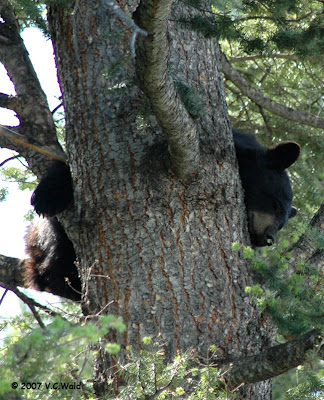
The photo* is of a very relaxed black bear, taken just south of Upper Terrace Drive, Mammoth, WY (Yellowstone National Park), on Saturday, June 16. This guy doesn't look like much of a threat snoring away up there in the tree, though I guess he could fall out on your head as you hike, oblivious, below...
And in other news...my favorite bear, grizzly sow #399, let some guy have it last week . I am sorry he had to suffer the pain and indignity of "lacerations to his backside" but he lived to serve as a reminder that as beautiful and watchable as #399 and her big brood are, and as much as she is is inclined to hang around roads and lodges, she is still a real, and a serious, bear, rising to the occasion when she feels she or her cubs or their food is threatened.
*Not my technically best, sorry, but you get the idea.
Monday, June 4, 2007
Why you should keep your bear spray at hand
http://vids.myspace.com/index.cfm?fuseaction=vids.individual&videoid=1249608579
I've not seen nor heard of an encounter like this before. The guy had more presence of mind than I would have and kept the camera rolling...
Monday, May 28, 2007
The monarchs aren't here yet, but it IS Spring
 In Chicago today we've had the kind of weather that belies the conviction that we have no Spring, and that we bypass that favorite of seasons, moving from too cold to too hot, with no in-between. Today it was in-between, and even if that's all we get, it sure was a pleasure while it lasted.
In Chicago today we've had the kind of weather that belies the conviction that we have no Spring, and that we bypass that favorite of seasons, moving from too cold to too hot, with no in-between. Today it was in-between, and even if that's all we get, it sure was a pleasure while it lasted.05/29/2007 P.S. No monarchs yet, but this morning I was surprised by a black swallowtail slurping up sweetness from my neighbor's flower garden.
Sunday, May 27, 2007
A case of schizophrenia
D
Botkin uses the Lewis and Clark expedition as the basis from which to illustrate his lessons on evolution of landforms, flora, fauna, and above all, river ecology and riparian environments. His frame ranges from the earliest geologic eras to the present, using the wonderfully detailed Meriwether Lewis and William Clark diaries as the starting point for comparisons both back and forward through time. The spread of the Anglo-European population along the route of the Corps of Discovery, and the resultant economic pressures, are among the largest of the forces he describes. It’s a very bright device, especially because the author quotes liberally from the diaries; the imagery and accuracy of their descriptions cannot be duplicated, and their notoriously inventive grammar and spelling are irresistible.
More suggestions for improvement:
Clear line-drawn maps would have added greatly to the utility of this book, as would a bibliography or further readings list. Finally, there are places in which interpretations of antiquated usages and extreme misspellings of Lewis and Clark quotes would have been in order For instance, on p. 185, Clark’s description of river fauna refers to a “bottle nose.” It’s clear only that it’s unlikely he was speaking of a dolphin
The good news:
Having nailed this book for its distracting weaknesses, I want to emphasize that it nonetheless contains important messages delivered in a useful ways. The concepts are magnified by Botkin’s deep appreciation of his objects of study: the geological, biological, and specifically human ecology of two of North America’s great watersheds, those of the Missouri and the Columbia. It is also evident, in spite of his failure to demand quality editing (even on his own home page: http://www.danielbbotkin.com/about/) that Botkin is a competent scholar with a history of academic accomplishment. He served on the faculty at University of California, Santa Barbara, and brings the authority of a doctorate in biology/plant ecology from Rutgers to this work intended for the non-scholarly audience.
Besides retelling the ever-wonderful story of Lewis’ and Clark’s journey, highlighting their observational powers and dedication to accurately recording what they saw, Botkin’s agenda includes enlightening the reader with regard to two popular misconceptions about how nature works.
The author discusses how the first major North American urban areas grew up around rivers, and how their inner cities have survived the test of time as long as the “connection” with the waterways was maintained in social, humanistic, and aesthetic senses. St. Louis, while still economically and industrially attached to the Mississippi, erected effective barriers – such as the unfortunate placement of Interstate highways - to individual relationships with that water. He claims that in spite of expensive public efforts to restore St. Louis’ inner city, none have truly succeeded, and it is because of the disconnect with the river.
Elsewhere, Botkin provides a fair discussion of the context in which past ruinations, such as damming the Missouri and Columbia Rivers, were in fact, economically beneficial, allowing riverside agriculture to flourish, at least in years of normal flows. But Botkin’s surprising conclusion is that the salvation of the natural environment is in urbanization, positing that the more humans confine their living to the metropolitan, the more we will treasure the wild, and the less we will intrude upon it for living space. I find this to fall more in the “wishful-thinking” column than in the “useful-solutions” column, but it is nonetheless food for thought.
Monday, May 14, 2007
There's poetry in there somewhere

I've just returned from a long weekend in Utah that began with an unusual clear-day, early morning flight from Chicago to Salt Lake City. Being a window-seat type - to me, there's no joy in flying unless I can watch the world go by from on high - I took a few notes as we fled Chicago, crossed the Mighty Mississip and made our way westward. This is what I had when I opened my notebook again this morning:
peaks valleys canyons
escarpments ridges
aretes
snow water desert green
rivers lakes pools and
ponds
irrigation, parched
red, green, beige, blue, brown, tan, sand yellow
rises and dips
erosion, large and small scale
man made and not man made
rumpled and smooth
broken and whole
river beds and lake beds
straight and straightened
meandering and dammed
All of this before we even got near the Rocky Mountains. This is a photo of the Colorado highlands taken along the same flightpath last February.
Monday, April 30, 2007
I spoke too soon

Today the Graduate School of Business (since renamed the Booth School of Business) got its first avian mortality of the spring of 2007. It looked like a wood thrush - it's hard to tell from beneath - along the south face of the glass tower. There was also a stunned little warbler on the east face. I believe it eventually recovered and flew off. Migration is really in full swing now, we can expect one, two, up to five or six deadly strikes per day until mid-summer. The bodies go to the Field Museum of Natural History for identification, sexing, determination of condition (e.g., body fat measurements), and correlation with weather conditions on the date of mortality. One way to salvage a bad situation.
Thanks to www.ChicagoGSB.edu for the interior shot of the glass tower.
Monday, April 23, 2007
I'M alive!

I'm alive - just too busy with projects, projects, projects to blog. So today I'm simply acknowledging that spring has truly arrived in Chicago.
And one further spring comment: unaccountably, since song bird migration is fully underway here, we have not had one single mortality from a window strike at the Chicago Graduate School of Business where I work. This compares to dozens, if not more than a hundred, by this time in previous years.
Anemones from last spring, on the University of Chicago campus.
Friday, April 13, 2007
They're alive!
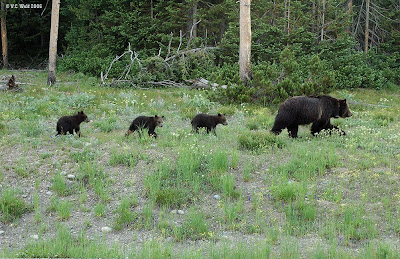
I found out today that all three grizzly cubs survived their first winter and are out and visible in Grand Teton National Park. Here are my notes from the first time I saw them, June 13, 2006
"Then I went on up to Colter Bay and just before the turnoff – literally a hundred yards from the sign, SHE and her three clowns emerged. I was the first to see bear 399 (who is collared, said to be 10 years old, and to have lost her only previous cub, last year.) Of course I wasn’t the only one for long, but that early – it was about 6:40 – there aren’t a lot of people around. She led the kids southward along the embankment above the road for a bit, then crossed, then crossed back into the trees. What an absolute thrill, such a handsome dark chocolate bear. It’ll be a miracle if more than one cub survives two years, but right now the little boogers are quite the handful."
My emphasis on SHE refered to the fact that I had been in the park for several days and this bear and her cubs had been seen by literally hundreds of people, except me. I saw them once more, the following morning. But I never expected to hear that all three cub survived the winter - albeit a mild one. They are still at great risk, most especially from boar grizzlies, but at least the first great hurdle has been surmounted. In fact, it may very well be that the reason the sow stays in the vicinity of the road and human activity is that the adult males might be less inclined to bother her and her brood there.God willing, they will still be around and visible when I get there again in June.
Monday, April 9, 2007
Wildlife attachments

I am well into Doug Smith and Gary Ferguson’s wonderful Decade of the Wolf, the felicitously written, fascinating story of gray wolf reintroduction to the Greater Yellowstone ecosystem. I might add, one more reason the book is notable to me is that the cover photo was taken by my friend Doug Dance.
From early February, 2004, slightly edited for clarity:
“The strength of people’s reactions to 42’s death is amazing. I understand how people become so attached to wild animals they see over many seasons. Inadvisable though that is from the strictly intellectual standpoint, I’ve watched myself get that way about “my” peregrine falcons. We humans read doggie body language so readily, even the untrained and casual wolf-watcher can relate to what’s going on. I have a feeling there’s an evolutionary reason these things [i.e., rearrangement of pack membership and heirarchy] happen, and that the fears that the Druid pack will disintegrate and so on may be valid to the extent that new alliances can now form to keep the gene pool properly mixed up. I’m pretty sure there will always be wolves to watch in Lamar, though, or at least if there aren’t, it won’t be because of changes brought about by 42’s death.
But Mother Nature can be incredibly cruel. Watching a new moose calf stranded in the middle of a rushing river in the Tetons, knowing that it would soon collapse and be carried down stream to become fish food, and seeing a cow elk’s hopeless panic after a bear disappeared into the copse where her calf was hidden resounded with me for months afterwards. We just have to keep in mind, there is also always reason to rejoice. I have my own nice example: you might remember that I bemoaned the fact that the church where “my” falcons nested, a few blocks from my office, had to take the spire off their steeple last spring, so the falcons lost their scrape and are thought not to have reproduced at all in 2003. Good news! In the last couple of days I have seen a male and female falcon feeding together on another building, across the street from where I wait for the bus home every day. They are still in the neighborhood, and if they’re feeding here, probably have found a place suitable to lay eggs nearby. Life does go on!”
The photo is of my friend BPF, to whom I wrote the original message about 42. He checked out the perimeter of Lake of the Woods (in Yellowstone) before we circumambulated it in October of 2004. We found piles of clean elk and other bones on the far side, probably brought there by wolves or coyotes.
Friday, March 30, 2007
A Smart Car?
 Today I saw my very first Stateside Smart Car Fortwo, here in my home neighborhood of Hyde Park, Chicago. What a cute little toy. I would not get on that notoriously cut-throat-truck-choked-strip-of-road-rage Dan Ryan Expressway in it for the world. It is nonetheless an interesting sign, perhaps (but not likely) a portend of things to come. In spite of the tough urban parking situation and a reasonably environmentally conscientious neighborhood culture, SUVs are more the rule than the exception (though happily it's been a while since I saw a Hummer cruise through here). I was on a city bus - efficient, if polluting, transportation - so I could see down into the cabin. It's very tiny, and I doubt there's room for a bag of groceries in the back if the front is occupied by a driver and passenger. It's unlikely that it would be a usable only-car, especially given that for the $15,000 price there are many other more capacious, adequately powered, and practical options on the market. However, for those zipping around close to home on flat terrain with no need to schlep stuff, wouldn't it make a great second car?
Today I saw my very first Stateside Smart Car Fortwo, here in my home neighborhood of Hyde Park, Chicago. What a cute little toy. I would not get on that notoriously cut-throat-truck-choked-strip-of-road-rage Dan Ryan Expressway in it for the world. It is nonetheless an interesting sign, perhaps (but not likely) a portend of things to come. In spite of the tough urban parking situation and a reasonably environmentally conscientious neighborhood culture, SUVs are more the rule than the exception (though happily it's been a while since I saw a Hummer cruise through here). I was on a city bus - efficient, if polluting, transportation - so I could see down into the cabin. It's very tiny, and I doubt there's room for a bag of groceries in the back if the front is occupied by a driver and passenger. It's unlikely that it would be a usable only-car, especially given that for the $15,000 price there are many other more capacious, adequately powered, and practical options on the market. However, for those zipping around close to home on flat terrain with no need to schlep stuff, wouldn't it make a great second car?Thanks to http://smartcarfortwo.com/ for the image.
Wednesday, March 21, 2007
What crows do
There's a flat roof immediately below my office window covered with roundish pale-colored rocks that average maybe 1½ or 2 inches in diameter. Here in Chicago we have a plethora of crows. I just watched one alight on the roof and meticulously stuff something it brought in its beak between the rocks, and oh-so-purposefully heap, one by one, three or four more heavy little rocks on top, making a mini-cairn. In the jumble, from the angle of my desk chair, I can’t now distinguish the cairn from the rest of the rocks. It makes me wonder if the crow made the cairn to identify the cache later, or if the little pile was only incidental to its effort to preserve its treasure by the burial method. If the latter is the case, what marker will it use to relocate what it buried?
Tuesday, March 20, 2007
For merinz
Monday, March 19, 2007
Random musical firings
Best Crooner (ever): Nat King Cole
Best Down-n-Dirty Disguised as Youthfully and Eternally Perky: Lily Allen
Who knew?
Sunday, March 18, 2007
Seasons

Change of season: clearly spring is coming very soon to Chicago and environs. I'm by no means ready to let winter go. 2006-2007 was another unsatisfyingly warm and snow-sparse winter in the American midwest. Without a very cold winter, with prolonged freezing and good snow cover, the rest of the year risks drifting out of kilter. Birds migrate inappropriately soon and late; trees and other plants bud at risk of frost-bite; fruits ripen when they shouldn't,, and the animals that depend on them fatten up too early and never experience the stress needed to metabolize that fat as designed. While short winters translate to lower consumption of heating fuels, we spend the energy on cooling instead. Is it global or cyclical, permanent or transitory? I don't know, so I'll just go take my recycling down to the bins now.
Photo taken at the Chicago Botanic Gardens in mid-summer 2004.
Sunday, March 11, 2007
Home Depot at the cutting edge
Saturday, March 10, 2007
Happy birthday, Mother
Friday, March 9, 2007
Birds and the City

For the first time in many months I spotted a peregrine falcon on the campus of the University of Chicago yesterday. For five or six years a pair successfully fledged chicks on the ledge of steeple that backed against the base of the spire on the First Unitarian Church of Chicago at 57th Street and Woodlawn. The pair, known as Magnolia and Orion, was one of several captive-bred by Chicago Peregrine Release and Restoration (now under the rubric of the Field Museum of Natural History in Chicago.) That location was fortuitous because it was possible, if not exactly easy, to belay out the steeple window to nab the chicks to winch inside long enough to draw a sample of DNA and to sex (easy with peregrines) and band them. When the church dismantled its unsalvageable steeple several seasons ago, the birds experimented with other locations on the University of Chicago campus, favoring especially the rain gutters on Kelly-Green and Cobb Halls. Peregrines are known for their beauty and brawn, but not for their brains. Each time the hen produced a promising clutch of beautiful rusty-brown eggs, the eggs would die in the next gully-washer. Last year it was discovered (based on the bands on the bird's legs) that Magnolia’s mate was not Orion, but one of their sons Eddie; their attempts at reproducing nonetheless continued to fail.
With no chicks to tie them to the campus, both adults eventually abandoned their regular roosts and since the middle of last summer it has been an increasingly rare treat to spot one. Yesterday I was sitting with a colleague, Hoyt Bleakley, whose office faces west. All of a sudden I saw that familiar fast and strong wing beat speeding directly at the window. Hoyt starts yelling “Pull up! Pull up!!” and of course the bird, a mature peregrine, did so just as we got a really good look at it – something like the last view of anything that some pigeons get. It’s likely it perched at the top of the Graduate School of Business’ Hyde Park Center’s glass tower, as I have occasionally seen one, and/or its sign, there. A few moments later the scene repeated itself except the view of the falcon was from the rear. It swiftly made its way straight west, then veered out of sight behind the outsized steeple of Rockefeller Chapel. Later that afternoon I spotted it on its familiar roost very high on the steeple.
Of course unless there is a mate, there won’t be chicks this year either. But the University of Chicago has made most generous efforts to support these rare birds by constructing first class next boxes mounted on the top of both Pick Hall and the Administration Building. The small clique of peregrine-watchers on campus is eternally optimistic that a pair will soon notice and make use of the commodious digs and start making new falcons again.
Tuesday, March 6, 2007
Just thinking of Yellowstone

I'm just thinking of Yellowstone instead of RealLife in Chicago. The vision in this image, taken in the Upper Geyser Basin in February of this year, will fade soon. Though there will still be wintery temperatures and impressive snow storms before summer marches irreversibly in, the longer days and ever-more vertical sun will melt the snow and mitigate the steam. In only a couple of months I will be on my way again.
Saturday, March 3, 2007
Loss

I didn’t realize how much I liked this little Native American-made turquoise and silver necklace until it disappeared from around my neck on February 28. I bought it on eBay a couple of years ago – in fact the photo is the seller’s, not mine – for not very much money. My efforts to find it, or to let the finder know I’m mourning and pleading for its return, are fruitless so far. So this morning I decided to scour eBay to see if there’s anything that could replace it at a price I’m willing to pay, as is the way of theBay. I searched on “turquoise necklace” minus a few key words, which I think is how I happened on it in the first place. eBay is an interesting market, and for the knowledgeable, patient, and careful buyer, can occasionally provide exceptional items at costs far below value. In 66 pages of hits I found very interesting items and examples of extraordinary creativity and aesthetic. My query did not turn up the perfect substitute. I did, on the other hand, find hundreds of American, Tibetan, Chinese, African and Thai turquoise, faux, and glass, and plastic necklaces variously represented and mis-represented as rare, exotic, huge, charming, museum-quality, vintage, and unique, and a couple, most oxymoronically, as “yellow” or “pink” turquoise. Some are so complicated that I wouldn’t know how to wind them around my neck. Origins are QVC and Chico’s, grandmother’s jewelry box, estates, Indian markets, Taxco, and pawn shops in Gallup. Lots of sellers have naively inflated ideas of the source and worth of their items. I had a good laugh over misspellings, like “gradulated” beads. Some offerings are very appealing and very fine indeed. Buyers recognize that and bidding is hot from the get-go. More are funny, funky, cheesy and tacky, but the most distinct thing about them is that they are saleable at all.
